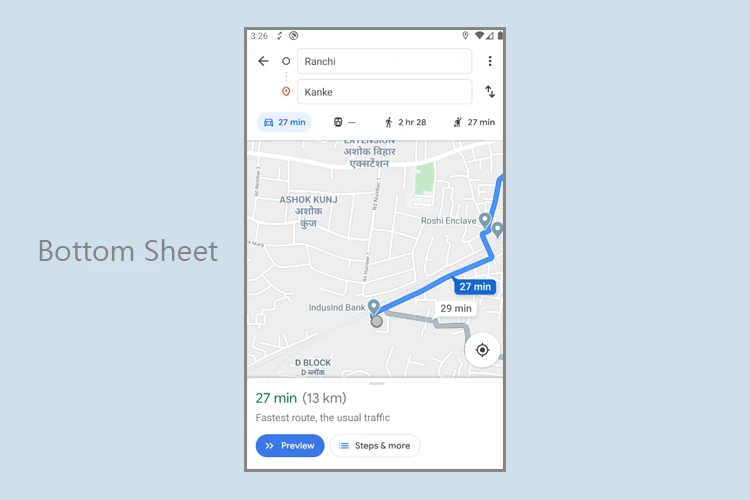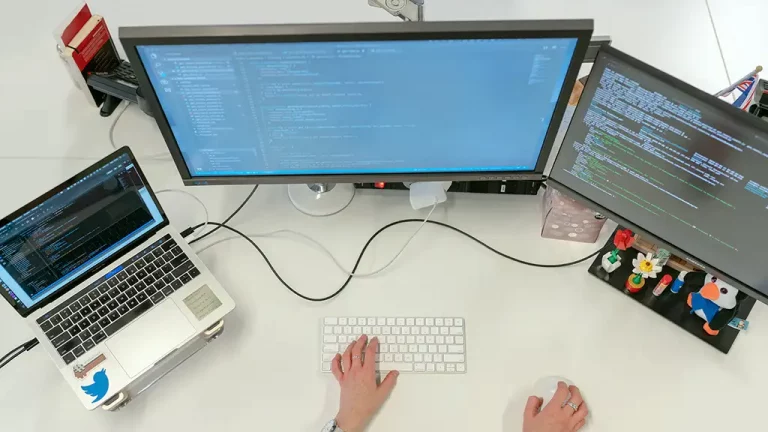Have you seen the Bottom Sheet Android Component? It slides up from the Bottom to display some more options to the user. I am pretty sure that you have already seen Bottom Sheet in Google Maps application.

You can also use the Bottom Sheet in your application. And if you want to use it in your app, in this post, I will guide you about integrating the android Bottom sheet in your project.
You can also go through the official guide about the Bottom Sheet.
Table of Contents
Types of Bottom Sheet
#1 Persistent Bottom Sheet
As clear from the name, it is persistent at the bottom of the screen. A user can view the full Bottom Sheet by dragging the sheet up vertically. The Bottom Sheet is slightly elevated, and it can display more options or app content to the user. For example, the picture that we saw above is an example of a persistent bottom sheet.
#2 Modal Bottom Sheets
Again as the name suggests, these sheets behave like Modals or dialogues. It shadows the activity or fragment when activated. And if we tap outside the Bottom Sheet, it is dismissed just like a modal. A user can also slide up and slide down to activate and deactivate the Bottom Sheet, respectively.

I hope you got that what exactly is the android bottom sheet and when we can use it in our application. Now let’s learn how we can implement it in an Android Studio Project.
Persistent Bottom Sheet
Creating a new Project
- As always we need to create a new android studio project. And for this sample I have created a new android project with an Empty Activity.
- Now we will add the material design dependency in our project. To do this, open app level build.gradle file and inside the dependencies block add the following line.
|
1 2 3 4 |
//add material design to your project implementation 'com.google.android.material:material:1.3.0-alpha01' |
- Once you have added the above line a gradle sync is needed.
Designing Bottom Sheet
Now let’s design our Bottom Sheet. Here I won’t do some very complex or very beautiful design, but if you want to design your excellent layout, you can. As it is an example, I am creating a straightforward design.
- Inside your layout folder, create a file named bottom_sheet_persistent.xml and copy the following code.
|
1 2 3 4 5 6 7 8 9 10 11 12 13 14 15 16 17 18 19 20 21 22 23 24 25 26 27 28 29 30 31 32 33 34 35 36 37 38 39 40 41 42 43 44 45 46 47 48 49 50 51 52 53 54 55 56 57 58 59 60 61 62 63 64 65 66 67 68 69 70 71 72 73 74 75 76 77 78 79 80 81 82 83 84 85 86 87 88 89 90 91 92 93 94 95 96 97 98 99 100 101 102 103 104 105 106 |
<?xml version="1.0" encoding="utf-8"?> <androidx.constraintlayout.widget.ConstraintLayout xmlns:android="http://schemas.android.com/apk/res/android" xmlns:app="http://schemas.android.com/apk/res-auto" android:layout_width="match_parent" android:layout_height="wrap_content" android:background="#ffffff" android:paddingBottom="32dp"> <ImageView android:id="@+id/imageView" android:layout_width="35dp" android:layout_height="35dp" android:layout_marginStart="16dp" android:layout_marginTop="16dp" app:layout_constraintStart_toStartOf="parent" app:layout_constraintTop_toTopOf="parent" app:srcCompat="@drawable/ic_user" /> <TextView android:id="@+id/textView" android:layout_width="wrap_content" android:layout_height="wrap_content" android:layout_marginStart="8dp" android:text="Sophia Connors" android:textColor="#292929" android:textSize="16sp" app:layout_constraintBottom_toBottomOf="@+id/imageView" app:layout_constraintStart_toEndOf="@+id/imageView" app:layout_constraintTop_toTopOf="@+id/imageView" /> <ImageView android:id="@+id/imageView2" android:layout_width="wrap_content" android:layout_height="wrap_content" android:layout_marginStart="16dp" android:layout_marginTop="32dp" app:layout_constraintStart_toStartOf="parent" app:layout_constraintTop_toBottomOf="@+id/imageView" app:srcCompat="@drawable/ic_call" /> <TextView android:id="@+id/textView2" android:layout_width="wrap_content" android:layout_height="wrap_content" android:layout_marginStart="8dp" android:text="(650) 555-1122" android:textColor="#292929" android:textSize="14sp" app:layout_constraintBottom_toBottomOf="@+id/imageView2" app:layout_constraintStart_toEndOf="@+id/imageView" app:layout_constraintTop_toTopOf="@+id/imageView2" /> <TextView android:id="@+id/textView3" android:layout_width="wrap_content" android:layout_height="wrap_content" android:layout_marginTop="4dp" android:text="Mobile" android:textSize="12sp" app:layout_constraintStart_toStartOf="@+id/textView2" app:layout_constraintTop_toBottomOf="@+id/textView2" /> <View android:id="@+id/view" android:layout_width="wrap_content" android:layout_height="1dp" android:layout_marginTop="12dp" android:background="#A3A3A3" app:layout_constraintEnd_toEndOf="parent" app:layout_constraintHorizontal_bias="0.0" app:layout_constraintStart_toStartOf="@+id/textView3" app:layout_constraintTop_toBottomOf="@+id/textView3" /> <ImageView android:id="@+id/imageView3" android:layout_width="wrap_content" android:layout_height="wrap_content" android:layout_marginStart="16dp" android:layout_marginTop="16dp" app:layout_constraintStart_toStartOf="parent" app:layout_constraintTop_toBottomOf="@+id/view" app:srcCompat="@drawable/ic_email" /> <TextView android:id="@+id/textView4" android:layout_width="wrap_content" android:layout_height="wrap_content" android:text="sophiacon@gmail.com" android:textColor="#292929" android:textSize="16sp" app:layout_constraintBottom_toBottomOf="@+id/imageView3" app:layout_constraintStart_toStartOf="@+id/view" app:layout_constraintTop_toTopOf="@+id/imageView3" /> <TextView android:id="@+id/textView5" android:layout_width="wrap_content" android:layout_height="wrap_content" android:text="Personal" android:textSize="12sp" app:layout_constraintStart_toStartOf="@+id/textView4" app:layout_constraintTop_toBottomOf="@+id/textView4" /> </androidx.constraintlayout.widget.ConstraintLayout> |
- The above layout will look something like this.

- But the above layout is just a simple XML layout and not a Bottom Sheet. And that is why to make the above layout a Bottom Sheet, we need to add some properties to the root layout.
- Add these new properties to the root layout of the design, as you can see below.
|
1 2 3 4 5 6 7 8 9 10 11 12 13 |
<?xml version="1.0" encoding="utf-8"?> <androidx.constraintlayout.widget.ConstraintLayout xmlns:android="http://schemas.android.com/apk/res/android" xmlns:app="http://schemas.android.com/apk/res-auto" android:layout_width="match_parent" android:layout_height="wrap_content" android:background="#ffffff" android:paddingBottom="32dp" android:id="@+id/bottomSheet" app:behavior_hideable="true" app:behavior_peekHeight="16dp" app:layout_behavior="com.google.android.material.bottomsheet.BottomSheetBehavior"> |
- As you can see 3 more properties are added here.
- behavior_hideable: It is true, that means we can completely hide the bottom sheet by sliding it down.
- behavior_peekHeight: It is the height of the sheet that will be visible.
- layout_behavior: It is most important property, as it defines the layout as a Bottom Sheet.
- I also added in ID, it is required to access the sheet in our code.
Adding Bottom Sheet to Activity
Our sheet is ready and now we can use it in our Activity or Fragment. We already have a default activity in our existing project that is the MainActivity and here we will add the Bottom Sheet.
- Open activity_main.xml and write the following xml code.
|
1 2 3 4 5 6 7 8 9 10 11 12 13 14 |
<?xml version="1.0" encoding="utf-8"?> <androidx.coordinatorlayout.widget.CoordinatorLayout xmlns:android="http://schemas.android.com/apk/res/android" xmlns:app="http://schemas.android.com/apk/res-auto" xmlns:tools="http://schemas.android.com/tools" android:layout_width="match_parent" android:background="#E7E7E7" android:layout_height="match_parent" tools:context=".MainActivity"> <include layout="@layout/bottom_sheet_persistent" /> </androidx.coordinatorlayout.widget.CoordinatorLayout> |
Remember for Bottom Sheet, we need CoordinatorLayout. And here we are including the Bottom Sheet that we designed. The above xml code will generate the following view.

We can see the Bottom Sheet in our Activity, and we can also slide it up or slide it down.
Now, let’s see how we can access the BottomSheet in the code to make changes.
Expanding and Collapsing Bottom Sheet
- First we will add a button in our activity_main.xml.
|
1 2 3 4 5 6 7 8 9 10 11 12 13 14 15 16 17 18 19 20 21 22 23 24 25 26 27 28 29 |
<?xml version="1.0" encoding="utf-8"?> <androidx.coordinatorlayout.widget.CoordinatorLayout xmlns:android="http://schemas.android.com/apk/res/android" xmlns:app="http://schemas.android.com/apk/res-auto" xmlns:tools="http://schemas.android.com/tools" android:layout_width="match_parent" android:layout_height="match_parent" android:background="#E7E7E7" tools:context=".MainActivity"> <LinearLayout android:layout_width="match_parent" android:layout_height="wrap_content" android:orientation="vertical"> <Button android:id="@+id/buttonBottomSheetPersistent" android:layout_width="wrap_content" android:layout_height="wrap_content" android:layout_gravity="center_horizontal" android:layout_margin="16dp" android:text="Open Persistent Bottom Sheet" /> </LinearLayout> <include layout="@layout/bottom_sheet_persistent" /> </androidx.coordinatorlayout.widget.CoordinatorLayout> |
- Then write the following code in MainActivity.kt.
|
1 2 3 4 5 6 7 8 9 10 11 12 13 14 15 16 17 18 19 20 21 22 23 24 25 26 27 28 29 30 31 32 33 34 35 36 37 38 39 40 41 |
class MainActivity : AppCompatActivity() { //#1 Defining a BottomSheetBehavior instance private lateinit var bottomSheetBehavior: BottomSheetBehavior<ConstraintLayout> override fun onCreate(savedInstanceState: Bundle?) { super.onCreate(savedInstanceState) setContentView(R.layout.activity_main) //#2 Initializing the BottomSheetBehavior bottomSheetBehavior = BottomSheetBehavior.from(bottomSheet) //#3 Listening to State Changes of BottomSheet bottomSheetBehavior.addBottomSheetCallback(object : BottomSheetBehavior.BottomSheetCallback() { override fun onSlide(bottomSheet: View, slideOffset: Float) { } override fun onStateChanged(bottomSheet: View, newState: Int) { buttonBottomSheetPersistent.text = when (newState) { BottomSheetBehavior.STATE_EXPANDED -> "Close Persistent Bottom Sheet" BottomSheetBehavior.STATE_COLLAPSED -> "Open Persistent Bottom Sheet" else -> "Persistent Bottom Sheet" } } }) //#4 Changing the BottomSheet State on ButtonClick buttonBottomSheetPersistent.setOnClickListener { val state = if (bottomSheetBehavior.state == BottomSheetBehavior.STATE_EXPANDED) BottomSheetBehavior.STATE_COLLAPSED else BottomSheetBehavior.STATE_EXPANDED bottomSheetBehavior.state = state } } } |
- The code is very simple and self explanatory. In case you have any question, please leave your comments below.

This is the Persistent Bottom Sheet, now let’s learn about Modal Bottom Sheet.
Modal Bottom Sheet
Designing Bottom Sheet
- For this, we will create a new xml layout file named bottom_sheet_modal.xml.
|
1 2 3 4 5 6 7 8 9 10 11 12 13 |
<?xml version="1.0" encoding="utf-8"?> <LinearLayout xmlns:android="http://schemas.android.com/apk/res/android" android:layout_width="match_parent" android:layout_height="wrap_content"> <ListView android:id="@+id/listViewOptions" android:layout_width="match_parent" android:layout_height="match_parent" /> </LinearLayout> |
We often use Modal Bottom Sheets to give user more options. And that is why I have a list here, and we will add options to this list in the code.
BottomSheetDialogFragment
We will create our Modal Bottom Sheet using BottomSheetDialogFragment. It is almost same as creating a DialogFragment. And it is also the subclass of DialogFragment.
- Create a new class named MyBottomSheetDialogFragment and write the following code.
|
1 2 3 4 5 6 7 8 9 10 11 12 13 14 15 16 17 18 19 20 21 22 23 24 25 26 27 28 29 |
class MyBottomSheetDialogFragment : BottomSheetDialogFragment() { override fun onCreateView( inflater: LayoutInflater, container: ViewGroup?, savedInstanceState: Bundle? ): View? { return inflater.inflate(R.layout.bottom_sheet_modal, container, false) } override fun onActivityCreated(savedInstanceState: Bundle?) { super.onActivityCreated(savedInstanceState) val options = listOf<String>( "Share with Friends", "Bookmark", "Add to Favourites", "More Information" ) listViewOptions.adapter = ArrayAdapter<String>( requireContext(), android.R.layout.simple_list_item_1, options ) } } |
- We will fire this Bottom Sheet on a Button Click.
- So first add one more button in activity_main.xml.
|
1 2 3 4 5 6 7 8 9 |
<Button android:id="@+id/buttonBottomSheetModal" android:layout_width="wrap_content" android:layout_height="wrap_content" android:layout_gravity="center_horizontal" android:layout_margin="16dp" android:text="Open Modal Bottom Sheet" /> |
- And inside MainActivity.kt we will add the following piece of code.
|
1 2 3 4 5 6 7 |
buttonBottomSheetModal.setOnClickListener { MyBottomSheetDialogFragment().apply { show(supportFragmentManager, tag) } } |
- And that’s it, you can see your Bottom Sheet by clicking the newly created button.

Now, that’s it for this tutorial friends. In case you have any problem, feel free to comment it below.
Bottom Sheet Android Source Code
In case you need my source code, you can get it from here.
Bottom Sheet Android Source Code




